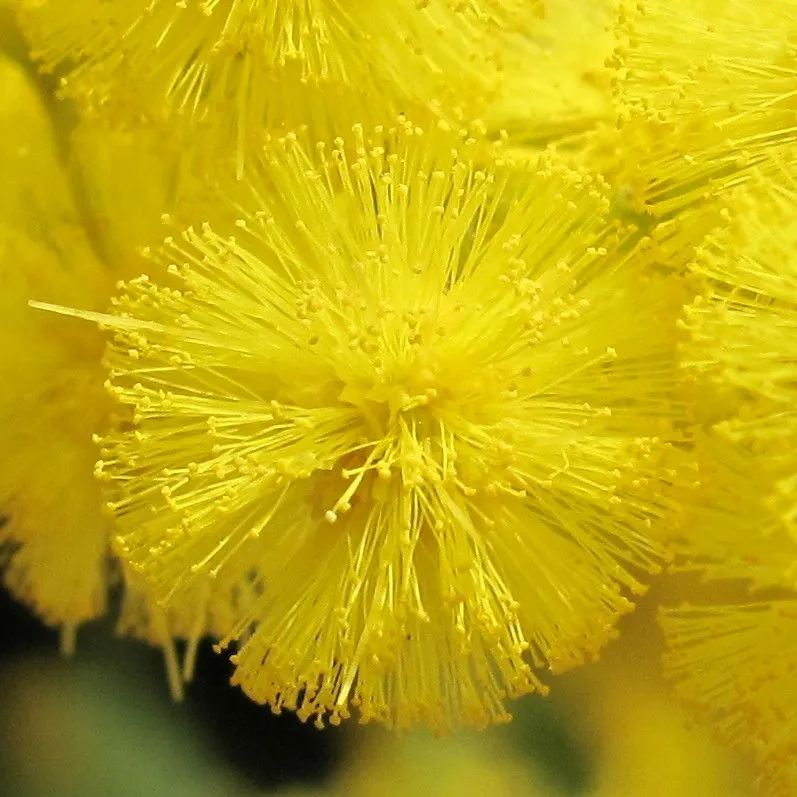
Author: Link
Bibliography: Enum. Hort. Berol. Alt. 1: 445 (1821)
Year: 1821
Status: accepted
Rank: species
Genus: Acacia
Vegetable: Unknown
Observations: SE. Australia
Mimosa, known scientifically as Acacia dealbata, is a captivating and versatile plant. Originating from southeastern Australia, this member of the Fabaceae family has successfully captured the interest of botanists and horticulturists alike since it was first documented by Link in 1821 in the work “Enumeratio Plantarum Horti Berolinensis Altera,” volume one, page 445.
The Mimosa is renowned for its delicate and feathery foliage, which displays a striking similarity to that of its more commonly known relative, the sensitive plant. The leaves tend to be a soft, silvery-green, giving the plant its other common name, the Silver Wattle. Another hallmark of this plant is its profuse blooming habit. In the late winter to early spring, it produces a stunning array of tiny, bright yellow flowers organized in spherical clusters. These charming blossoms are not only visually appealing but also emit a sweet, fragrant aroma that is highly attractive to a host of pollinators, including bees and butterflies.
The Mimosa thrives in a variety of conditions, demonstrating a noteworthy adaptability that contributes to its widespread cultivation beyond its native range. It prefers well-drained soils and a sunny position but can tolerate partial shade. Besides its ornamental value, Acacia dealbata is also valued for its practical applications, including usage in the production of perfumes due to its fragrant flowers, as a source of tannins in the leather industry, and even in traditional medicines by indigenous Australians.
In gardens and landscapes, this plant is often utilized as a decorative shrub or small tree. Its ability to provide vibrant color during the bleak winter months makes it a prized addition to horticultural displays. Furthermore, its fast-growing nature allows it to be used effectively for soil stabilization and erosion control.
Despite its many benefits, it’s important to note that in some regions outside its native habitat, the Mimosa can become invasive, outcompeting local flora and disrupting ecosystems. Therefore, responsible cultivation and management practices are recommended to control its spread.
In conclusion, Mimosa or Acacia dealbata is a distinguished plant with both aesthetic and practical merits. Whether admired for its beauty, utilized for its resources, or managed carefully to prevent ecological imbalance, this plant certainly holds a unique position in both botanical and horticultural contexts.
Ita: acacia mollissima, gaggia, mimosa, acacia bianca
Fra: mimosa, mimosa argenté, mimosa d’hiver, mimosa des fleuristes, acacia blanc
Deu: mimose, silberakazie, weißliche akazie
Eng: silver wattle, mimosa, blue wattle
Spa: acacia, acacia de hoja azul, acacia francesa, acácia-dealbata, alcacia, alcarcia, mimosa, panji
Por: acácia-dealbada, acácia-dealbata, acácia-prateada, mimosa, mimosa-prateada
Swe: silverakacia
Afr: silwerwattel
En: Mimosa, Silver wattle, Blue Wattle, Aroma, Acacia bernier
Af: Silwerwattel
Ar: سنط أطحل
Az: Sarı akasiya
Eu: Mimosa
Bg: Сребриста акация
Ca: Mimosa comuna, Mimosa plateada
Zh: 银荆
Cs: Akácie sivozelená
Da: Sølvakacie
Nl: Mimosa
Et: Hõbeakaatsia
Fi: Hopea-akasia, Hopea-akaasia
Fr: Acacia blanc, Mimosa, Mimosa argenté, Mimosa d’hiver, Mimosa des fleuristes, Mimosa blanchissant, Mimosa de Bormes
Gl: Mimosa
De: Weißliche Akazie, Silberakazie, Mimose, Weiβliche Akazie, Silber-Akazie, Australische Silberakazie, Echte Akazie
He: שיטה כסופה
Hu: Ezüst akácia
It: Acacia bianca, Acacia dealbata, Acacia mollissima, Gaggia, Mimosa
Kk: Мимоза
Mk: Мимоза
Ml: വെള്ളവാറ്റിൽ
Fa: آکاسیای نقرهای
Pl: Akacja srebrzysta
Pt: Acácia-dealbada, Acácia-dealbata, Acácia-prateada, Mimosa, Mimosa-prateada
Ru: Акация серебристая
Sr: Мимоза
Es: Mimosa, Acacia, Acacia de hoja azul, Acacia francesa, Acácia-dealbata, Alcacia, Alcarcia, Panji, Mimosa común
Sv: Silverakacia
Zh-tw: 德爾栲, 銀栲
Tr: Gümüşi akasya
Uk: Акація срібляста
Vi: Keo phấn trắng
Taken Feb 10, 2020 by Busqué Juan (cc-by-sa)
Taken Mar 17, 2013 by Tela Botanica − Liliane Roubaudi (cc-by-sa)
Taken Mar 16, 2013 by Tela Botanica − Pierre Bonnet (cc-by-sa)
Taken Aug 19, 2016 by Roberta Kelly (cc-by-sa)
Taken Oct 18, 2018 by Diana Gavino (cc-by-sa)
Taken Jun 30, 2018 by francois tissot (cc-by-sa)
Taken Jan 19, 2022 by Varrey Daniel (cc-by-sa)
Taken Jan 25, 2022 by Fabrice Rubio (cc-by-sa)
Taken Nov 6, 2017 by Mark Schaumann (cc-by-sa)
Taken Feb 14, 2018 by Fernando Muvi (cc-by-sa)
Taken Feb 29, 2020 by Laure Jubert (cc-by-sa)
Taken Feb 15, 2022 by Nathalie Potel (cc-by-sa)
Taken Jan 8, 2020 by periutz (cc-by-sa)
Taken Mar 20, 2022 by Caroline Champigny (cc-by-sa)
Taken Mar 4, 2012 by Tela Botanica − Marie PORTAS (cc-by-sa)
Taken May 17, 2021 by Christopher SWALE (cc-by-sa)
Taken Sep 8, 2019 by Corinne Jacquemay (cc-by-sa)
Taken Feb 2, 2022 by El Harrison (cc-by-sa)
Taken Jun 30, 2018 by francois tissot (cc-by-sa)
Taken Dec 10, 2021 by Jonathan Hobbs (cc-by-sa)
© copyright of the Board of Trustees of the Royal Botanic Gardens, Kew.
© copyright of the Board of Trustees of the Royal Botanic Gardens, Kew.
© copyright of the Board of Trustees of the Royal Botanic Gardens, Kew.
Taken Nov 26, 2021 by De Vincentis Davide (cc-by-sa)
Taken Feb 11, 2022 by Alexandros Galanidis (cc-by-sa)
Taken Feb 2, 2022 by El Harrison (cc-by-sa)
Taken Jan 26, 2022 by Giovanni Vannacci (cc-by-sa)
Taken Feb 17, 2022 by JYCO (cc-by-sa)
Taken Feb 25, 2017 by Paul Bonilla (cc-by-sa)
Taken Dec 8, 2019 by Correa Gregorio (cc-by-sa)
Taken Nov 26, 2021 by De Vincentis Davide (cc-by-sa)
Taken Jan 25, 2020 by Ciantia Ruben (cc-by-sa)
Taken Mar 16, 2013 by Tela Botanica − Pierre Bonnet (cc-by-sa)
Family: Myrtaceae Author: (F.Muell.) K.D.Hill & L.A.S.Johnson Bibliography: Telopea 6: 402 (1995) Year: 1995 Status:…
Family: Rubiaceae Author: Pierre ex A.Froehner Bibliography: Notizbl. Bot. Gart. Berlin-Dahlem 1: 237 (1897) Year:…
Family: Sapindaceae Author: Koidz. Bibliography: J. Coll. Sci. Imp. Univ. Tokyo 32(1): 38 (1911) Year:…
Family: Asteraceae Author: A.Gray Bibliography: Pacif. Railr. Rep.: 107 (1857) Year: 1857 Status: accepted Rank:…
Family: Fabaceae Author: Medik. Bibliography: Vorles. Churpfälz. Phys.-Ökon. Ges. 2: 398 (1787) Year: 1787 Status:…
Family: Aspleniaceae Author: (Cav.) Alston Bibliography: Bull. Misc. Inform. Kew 1932: 309 (1932) Year: 1932…